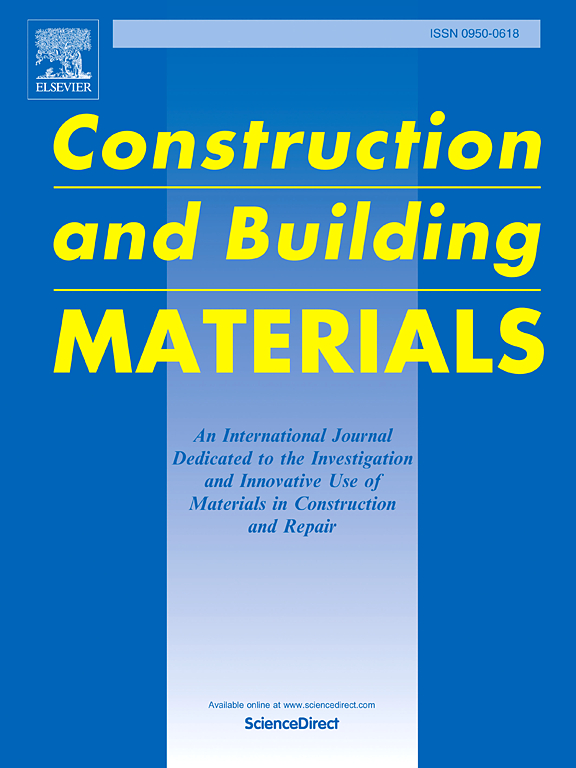橡胶/聚乙烯醇纤维复合增韧水泥稳定碎石:变形、耐久性和应力消除效果
IF 7.4
1区 工程技术
Q1 CONSTRUCTION & BUILDING TECHNOLOGY
引用次数: 0
摘要
为了提高水泥稳定碎石基的韧性,提高其抗裂性和耐久性,制备了橡胶/聚乙烯醇(PVA)纤维水泥稳定碎石基。提出了橡胶颗粒和聚乙烯醇纤维的预处理技术。系统地研究了橡胶/聚乙烯醇纤维CSM的变形特性。揭示了不同条件下的换热规律。阐明了橡胶/聚乙烯醇纤维CSM的疲劳性能和抗冻性能。研究了橡胶/聚乙烯醇纤维CSM的抗弯性能和应力消除效果。结果表明,与CSM、PVA纤维CSM和橡胶CSM相比,橡胶/PVA纤维CSM的干收缩应变可降低14.1 ~ 38.9 %;平均温度收缩系数可降低21.5 ~ 58.3 %。与CSM相比,橡胶/PVA纤维CSM在加热时的温差降低了16.6 %,在冷却时的温差降低了23.0 %。冻融循环后,橡胶/PVA纤维CSM的质量损失率和无侧限抗压强度损失率得到有效缓解。不同应力水平下的疲劳寿命可提高30.8 ~ 80.4 %,临界弯曲应变能密度可提高18.8 ~ 63.6 %。完全开裂后,应变减小42.8 ~ 54.3 %,裂纹扩展面积最小,有效地疏散了基体的内应力,延缓了裂纹的发展。本文章由计算机程序翻译,如有差异,请以英文原文为准。
Composite toughened cement stabilized macadam with rubber/PVA fiber: Deformation, durability and stress evacuation effect
To enhance the toughness of cement-stabilized macadam (CSM) base and improve its resistance to cracking and durability, rubber/ Polyvinyl Alcohol (PVA) fiber CSM was prepared. Techniques for the pre-treatment of rubber particles and PVA fibers were proposed. The deformation characteristics of rubber/PVA fiber CSM were systematically studied. The heat transfer rules under different conditions were revealed. The fatigue performance and frost resistance of rubber/PVA fiber CSM were clarified. The flexural performance and stress evacuation effect of rubber/PVA fiber CSM were elucidated. The results indicate that, compared to CSM, PVA fiber CSM, and rubber CSM, the dry shrinkage strain of rubber/PVA fiber CSM can be reduced by 14.1–38.9 %. The average temperature shrinkage coefficient can be reduced by 21.5–58.3 %. In comparison to CSM, rubber/PVA fiber CSM exhibits a 16.6 % reduction in temperature difference during heating and a 23.0 % reduction during cooling. The mass loss rate and unconfined compressive strength (UCS) loss rate after freeze-thaw cycles of rubber/PVA fiber CSM are effectively mitigated. The fatigue life at different stress levels can be increased by 30.8–80.4 %, and the critical flexural strain energy density can be improved by 18.8–63.6 %. After complete cracking, the strain can be reduced by 42.8–54.3 %, resulting in the smallest crack propagation area, which effectively evacuates the internal stress of the base and delays crack development.
求助全文
通过发布文献求助,成功后即可免费获取论文全文。
去求助
来源期刊

Construction and Building Materials
工程技术-材料科学:综合
CiteScore
13.80
自引率
21.60%
发文量
3632
审稿时长
82 days
期刊介绍:
Construction and Building Materials offers an international platform for sharing innovative and original research and development in the realm of construction and building materials, along with their practical applications in new projects and repair practices. The journal publishes a diverse array of pioneering research and application papers, detailing laboratory investigations and, to a limited extent, numerical analyses or reports on full-scale projects. Multi-part papers are discouraged.
Additionally, Construction and Building Materials features comprehensive case studies and insightful review articles that contribute to new insights in the field. Our focus is on papers related to construction materials, excluding those on structural engineering, geotechnics, and unbound highway layers. Covered materials and technologies encompass cement, concrete reinforcement, bricks and mortars, additives, corrosion technology, ceramics, timber, steel, polymers, glass fibers, recycled materials, bamboo, rammed earth, non-conventional building materials, bituminous materials, and applications in railway materials.
 求助内容:
求助内容: 应助结果提醒方式:
应助结果提醒方式:


